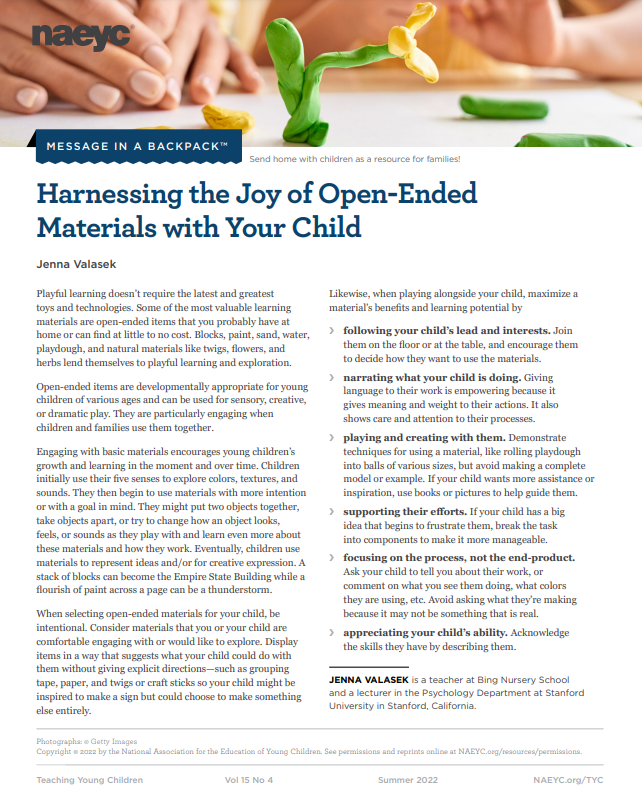Message in a Backpack™ Harnessing the Joy of Open-Ended Materials with Your Child

You are here
Playful learning doesn’t require the latest and greatest toys and technologies. Some of the most valuable learning materials are open-ended items that you probably have at home or can find at little to no cost. Blocks, paint, sand, water, playdough, and natural materials like twigs, flowers, and herbs lend themselves to playful learning and exploration.
Open-ended items are developmentally appropriate for young children of various ages and can be used for sensory, creative, or dramatic play. They are particularly engaging when children and families use them together.
Engaging with basic materials encourages young children’s growth and learning in the moment and over time. Children initially use their five senses to explore colors, textures, and sounds. They then begin to use materials with more intention or with a goal in mind. They might put two objects together, take objects apart, or try to change how an object looks, feels, or sounds as they play and learn even more about these materials and how they work. Eventually, children use materials to represent ideas and/or for creative expression. A stack of blocks can become the Empire State Building while a flourish of paint across a page can be a thunderstorm.
When selecting open-ended materials for your child, be intentional. Consider materials that you or your child are comfortable engaging with or would like to explore. Display items in a way that suggests what your child could do with them without giving explicit directions—such as grouping tape, paper, and twigs or craft sticks so your child might be inspired to make a sign but could choose to make something else entirely.
Likewise, when playing alongside your child, maximize a material’s benefits and learning potential by
- following your child’s lead and interests. Join them on the floor or at the table, and encourage them to decide how they want to use the materials.
- narrating what your child is doing. Giving language to their work is empowering because it gives meaning and weight to their actions. It also shows care and attention to their processes.
- playing and creating with them. Demonstrate techniques for using a material, like rolling playdough into balls of various sizes, but avoid making a complete model or example. If your child wants more assistance or inspiration, use books or pictures to help guide them.
- supporting their efforts. If your child has a big idea that begins to frustrate them, break the task into components to make it more manageable.
- focusing on the process, not the end-product. Ask your child to tell you about their work, or comment on what you see them doing, what colors they are using, etc. Avoid asking what they’re making because it may not be something that is real.
- appreciating your child’s ability. Acknowledge the skills they have by describing them.

Download PDF of "Harnessing the Joy of Open-Ended Materials with Your Child" (293 KB)
Jenna Valasek is a teacher at Bing Nursery School and a lecturer for the Psychology Department at Stanford University in Stanford, California.